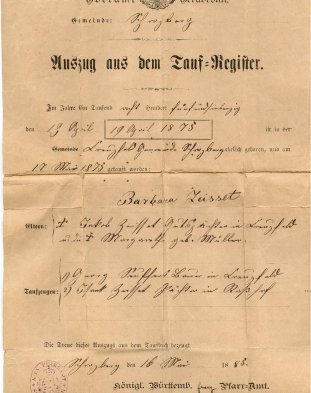
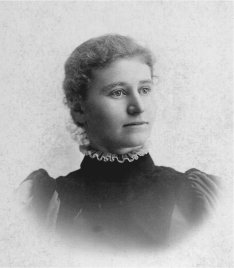
 |
Bettie Zeisset was born in Kreuzfeld, Wuerttemberg, Germany on April 19, 1875. Her given name was Barbara, but she was also called Babette. She was the tenth of twelve children born to Jakob Friedrich Zeisset and Margaretha Müller. Only six of the twelve children survived infancy. On the 20th of February 1881, Bettie’s mother died in childbirth. Her father died in prison from typhus when Bettie was 9 years old. He had been imprisoned for insurance fraud. After the father’s imprisonment, Bettie and her youngest brother, Henry, went to live with their uncle and aunt, Johannes and Elisabetha Zeisset at Niedersteinach. Bettie only lived at Niedersteinach for a year and then went with her 16-year-old sister, Bertha, to the United States. Bettie and Bertha traveled on the SS Fulda from Bremerhaven in northern Germany.
The two girls traveled in the steerage compartment with one piece of luggage for the two of them. They arrived in New York City on June 6, 1885. From there they traveled by train to Leonardville, Kansas. The family story passed down through the years says that the Baer family met them in Leonardville and took them to Alida in Dickinson County to live for a short while. The Henry Baer family was living in Alida at this time. Henry was a cousin of Bettie and Bertha, and had been born at Niedersteinach where Bettie lived briefly. Henry’s sister, Lena Baer, was married to Peter Baer and they had just moved north of Leonardville in March 1885 from Alida. Bettie soon went to live with the Peter Baer family north of Leonardville in the Crooked Creek area. Peter Baer would be renting from Mrs. Gustaf Brandenburg for four years. Bettie also lived at times with her sister Louise Swart, who lived in the same area.
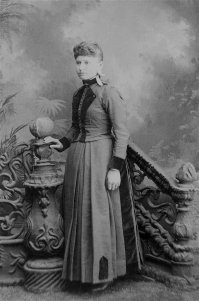
Bettie Zeisset, 1891 |
The first documentation of Bettie Zeisset in Leonardville is when she joined the Evangelical Church (later the United Methodist Church) in Leonardville in 1886, the 86th member to join the church. Her sister, Bertha, had already joined the church in 1885. Peter and Lena Baer joined the church at the time Bettie joined, suggesting that she lived with them then. Lena Baer’s sister, Anna Baer Bletscher, also joined the church in 1886. Most of the Baers and Bletschers had arrived in Kansas in September 1884. Peter Baer had come to Kansas with his brother-in-law Henry Baer in May 1880. Peter Baer, Jr. had come to Kansas in 1883.
Bettie attended school briefly at the Skow or Crooked Creek School north of Leonardville. Mae Johnson Hoerman, daughter-in-law of Bettie Zeisset reported that her mother, Anna Berggren, knew Bettie Zeisset when they were children because they had attended school together and we know that Anna Berggren attended the Skow School. Bettie did not complete the eighth grade however. It’s quite likely that she was expected to work, leaving little time for formal education. The children of Louise Zeisset and John Swart later attended school at the Skow school as well. The school was open from 1874-1946 and currently is a private home.
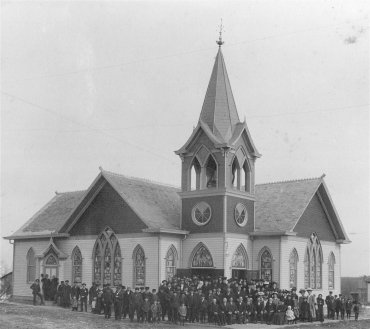
Evangelical Church, Leonardville, 1907 |
In 1893, when Bettie was 18 years old, she studied dressmaking with Mrs. Stadel, as reported in the Leonardville Monitor, the local newspaper of the time. Bettie’s daughter, Gladys Hoerman Llewelyn recalls that she was an excellent seamstress. In the 1895 agricultural census, Bettie was employed by Joseph A. Sparks. Mr. Sparks was a banker in Leonardville for a few years. He was originally from Michigan. His wife’s name was Margaret and they had a son named Leonard, born in 1885 in Nebraska. Bettie lived in the Sparks home and did housework, cooking and probably had some child care duties as well. One of her duties was to wipe down all the doorknobs in the house every Saturday. One day Bettie was making donuts. The fat was heating on the stove, waiting for the donuts, when Mrs. Sparks decided to let her pet bird out of the cage. The open grease and the free bird did not make a good combination, as the bird thought the grease was water, apparently. Not only did things end badly for the bird, but Bettie had to get different grease and heat it again before she could continue with the donuts.
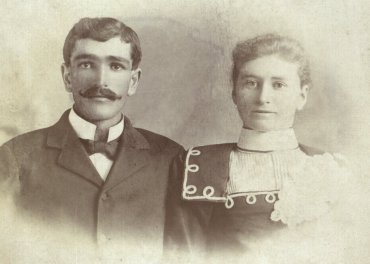 Bettie and Ludwig Hoerman, wedding photo, 1899 |
During Bettie’s youth, church attendance was an important activity. Probably through the youth gatherings, she met a young man she described as the most handsome man she had ever seen. This young man was Ludwig Hoerman, who went by “Lou”. He and Bettie Zeisset were married February 22, 1899 at the Evangelical parsonage by Rev. Manshardt when Bettie was 23 years old and Ludwig was 25.
Bettie and Lou established their first home in Goshen Township in Clay County. This was a home they rented located 3.5 miles north and one mile east of Green. The home was just north of a creek and Gladys remembers her mother telling her that she was always afraid the ducks would drown if the creek rose too swiftly. A second cousin of Lou’s named John Leipersberger immigrated to America in July 1899 and lived with the newlyweds, working for Lou as a hired hand.
The Hoerman family arrived in America August 25, 1883. They had relatives, the Schurle family, who had settled in Highland Township, Clay County, Kansas. Hoermans had lived at Bibersfeld, Germany since at least the mid-sixteenth century. The first spelling of the name in the church records is “Herman”, later “Horman”, and lastly “Hörrmann”. Without the umlaut over the “o”, it would be Hoerrmann.
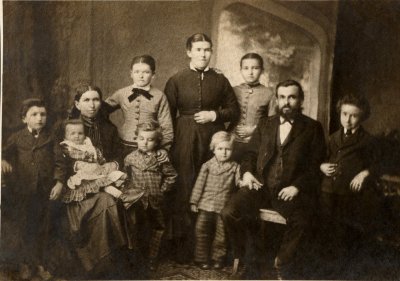
Hoerman family, 1881-1882 |
Andrew Hoerman, the fourth son of John and Kate Hoerman, born in 1878, began a journal in the 1950’s telling of his life. In it he says that they came to Clay County, in September and lived with “old acquaintances” for a time until they moved into an old stone house in the end of October. He tells of his older sisters being hired out to work for a dollar a week, while his brother (George) worked for a farmer for board and clothing.
John Hoerman, father of Lou and Andrew, was a blacksmith in Germany and was “financially well to do”. He had also served in the military in Germany, a soldier in the 4th Infantry Regiment. John did not marry his wife Christina Herterich until Jun 14, 1868, when she was six months pregnant with their 3rd daughter. John and Kate Hoerman left Germany primarily so that their sons would not have to serve in the military. In America, John learned to farm. There was plenty of blacksmith work to do, but farmers weren’t able to pay him. So he farmed. The Hoermans were members of the Evangelical Church in Leonardville.
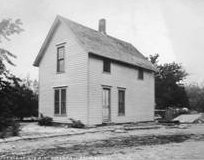
Farm home of Lou and Bettie as it appeared shortly after they moved to the farm west of Leonardville, 1902. The house was probably built by the previous owner. |
Lou Hoerman lived with his parents until his marriage to Bettie Zeisset. They lived on a rented farm north of Green, as mentioned previously.
In February 1901, Bettie and Lou’s first son, Lawrence Edward, was born.
The following year, in February, Lou purchased a farm adjacent to his father’s farm about three and a half miles west of Leonardville. The farm was purchased from John Nelson.
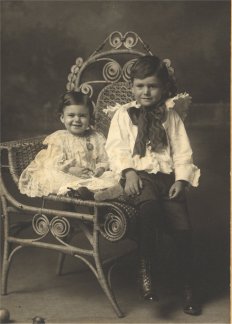
Louise (17 months of age) and Lawrence (4 ½ years old), August 1905 | 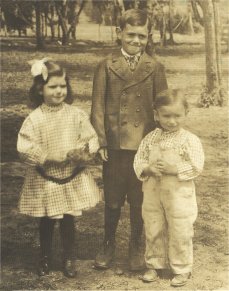
Louise, Lawrence, and Wilbert, c 1908 |
In March 1904, twin daughters, Louise and Gladdess were born to Lou and Bettie. Gladdess did not survive and was buried north of the house, probably where the current tile chicken house stands.
The next child to be born was named Wilbert. He arrived on the 28th of December 1905.
Twins were born again in June 1910, Gladys and Gertrude. In the family Bible, the twin of Louise was named Gladdess, which would be the German spelling. Bettie and Lou must have been fond of the name, using it again, but with the Americanized spelling. Gladys Llewelyn reports that a neighbor woman suggested that the twins be named Florena and Dorena.
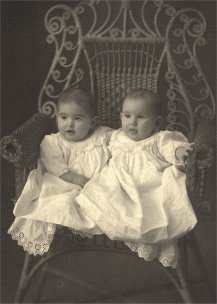
Gladys and Gertrude, 1910 | 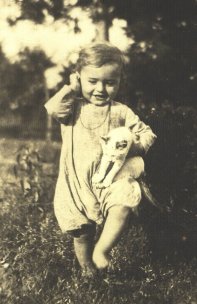
Johnnie, 1919 |
The last child, John Albert, was born in 1918. Lawrence used to get up early in the morning to start a fire in the stove so the house would be warm when then rest of the family got up. One day he had trouble starting the fire, added a little kerosene and caused the stove to explode, including the stovepipe which went through his parents’ bedroom. Everything was black. Gladys remembers that Johnny was sleeping in her parents’ bed and looked like a little black baby. The Bletscher girls were hired to help clean. It required much scrubbing to get everything and everyone clean. Johnny was a favorite everyone in the family, so it was especially tragic when he died in December 1919 from a ruptured appendix.
One story from this era which has been passed down is about a day when little Wilbert was lost. The family was looking everywhere for him and they were becoming quite concerned. Then Wilbert was found in the kitchen, sitting on the table eating syrup. He remained fond of syrup all of his life and one of the ways he especially liked it was poured over cottage cheese.
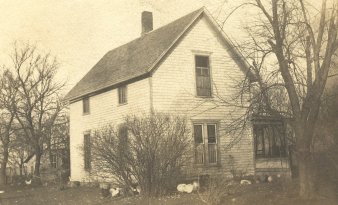
Hoerman home before 1918. A porch had been added to the original house. The chicken house can be seen behind the house to the north. |
The twins required extra work, sometimes more than others. Gladys told of a Saturday when her mother had scrubbed and mopped the kitchen floor, so as to be ready for Sunday. She left the dirty water from the scrubbing in a tub in the kitchen and went to do something else. Gertrude and Gladys were playing in the kitchen and proceeded to pull all the clean diapers from the bottom of the kitchen cupboard where they were kept and then put them in the tub of dirty water. And a long day just got longer. These were the days of washboards and wringer washers and clotheslines. Water was heated on the stove with a wood fire. It must have required a great deal of energy to live in those days. No wonder obesity is becoming an epidemic. Today we do all of these chores with very little physical effort.
The German families in this area visited each other frequently. Several families had emigrated from the area around Schwäbisch Hall in Germany. Many of these families settled at Highland township in Clay County and at Bala Township in Riley County. Louise Hoerman Cott told a story about visiting friends of her parents, the Trumpps. Wine and beer making in Germany were acceptable and part of the culture. The Germans, of course, brought these traditions with them. When she was only eight years old, Louise was given her first wine to drink. She didn’t think much of the drink, but as she sat there on her chair, she began to feel somewhat dizzy and was afraid she would fall off her chair. She wondered if the adults were having the same reaction. Imagine serving a glass of wine to an eight year old today! But in that time, children were expected to consume whatever was served. To do otherwise would be impolite.
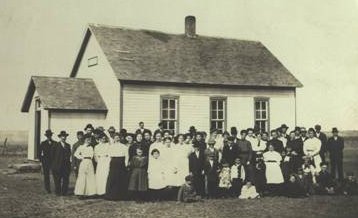
Laurel Hill school, 1911, last day of term. Louise is the first little girl in a white dress standing in the front row. Wilbert is the second boy standing to her left. |
The Hoerman children all attended school at the Laurel Hill school which was not quite a mile from their home. The school was along the road at the driveway to the home of John and Kate Hoerman. Wilbert told stories of putting caps in the stove which sat in the middle of the room and frightening everyone when they exploded. This was probably something that happened at every one room school at some time or another. And there were stories of taking the girls’ lunches and going up on the coal shed to eat them. Wilbert would have to hurry home before his sisters would get there to tell on him. Lawrence and Wilbert only attended school through the eighth grade as their help was needed on the farm.

Hoerman pigs, circa 1908. In background, Wilber is holding his father’s hand, Lawrence is off to the right. |
While Bettie was busy raising the children, Lou Hoerman was busy farming. Information from the 1905 Agricultural census shows that Lou owned 240 acres. This was the year that the son Wilbert was born. For the year of 1904, Lou had 40 acres of corn, 25 acres of oats and 35 acres of wheat. He cut 60 tons of hay in 1904. He had six horses, five milk cows and twenty-three other cattle. The census indicates that Bettie churned 500 pounds of butter in 1904. Lou had 53 hogs in 1904. Lou was particularly interested in the hog breed Chester Whites.
In 1915, at the next agricultural census, Lou still had 240 acres with corn, oats and wheat. He had seven horses, three milk cows and 32 hogs.
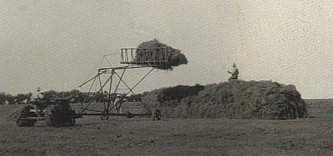
Haying at Hoermans in the 1920s. |
In 1925, Lou had 100 acres of corn, 50 acres of oats and 60 acres of wheat. He had 100 acres of prairie grass. He owned nine horses, six milk cows, 48 other cattle, 36 hogs, 60 sheep and 180 hens. The family also now had two dogs. In 1925, Lawrence was 24 years old, Louise was 21, Wilbert was not quite 20 and the twins, Gladys and Gertrude were 15 years old.
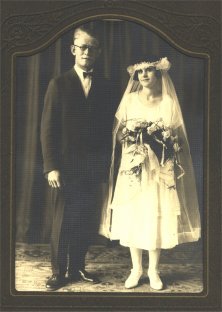
Herman and Louise Cott wedding photo, 1926 |
Louise, the oldest daughter, went Junction City to attend nursing school. She told of bringing a young man (Chris Mall) home to visit. Bettie always served something to eat to anyone who visited. For this particular visit, the only thing she found to serve was a bowl of prunes. Louise was quite embarrassed. Bettie was known for her cooking though and it wasn’t uncommon for a salesman to show up at meal time.
Louise told of nursing school and having to do the cleaning as well as maintaining wood in the stove to heat the hospital She would be left to manage these things in addition to the care of patients as a student nurse. While attending school, she met Herman Cott. They were married at her childhood home in June 1926 and moved to a limestone house which was the home of Herman’s father and sister. It was a large home and could easily accommodate the newlyweds. The wedding write-up in the Leonardville Monitor relates that Gertrude Hoerman played the wedding march. The marriage was perfomed by Rev. C. E. Platz, with Lawrence Hoerman as best man and Helena Cott as maid of honor. A “very sumptuous wedding dinner” was served after the ceremony. “Owing to the rain, the reception was deferred until Thursday evening”.
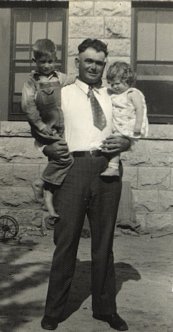
Lawrence Hoerman with his nephew Herman (Junior) and neice, Betty Lou Cott at the Cott home in about 1933 |
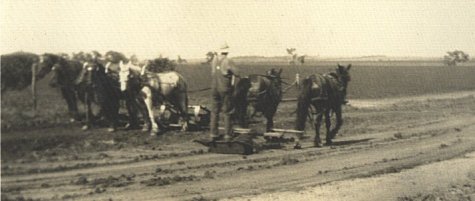
Lawrence grading Highway 24 |
Lawrence Hoerman worked for the county, maintaining the roads in Bala Township. At this time, highway 24 was just a dirt road. It wasn’t paved until sometime after the 1930s. The photo of Lawrence grading “highway 24”, shows the two teams he used, one he rode behind and the other he walked behind.
Lawrence never married. He developed a lymphoma and eventually lived at Mildford where he was cared for by his sister, Louise, until his death in 1935.
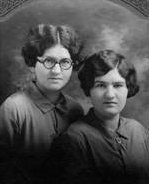
Gladys and Gertrude |
Gladys and Gertrude attended high school in Leonardville. Their grandfather, John Hoerman, died in 1911. After a time, Kate moved into the town of Leonardville. Gladys and Gertrude talked of going to visit their grandmother in town and having to speak German. Kate never learned to speak English. She was never happy about leaving her home country. Her husband, John returned twice to visit his family in Germany, but Kate never went because she reportedly said she would never return to America. Hoerman relatives living today in Germany tell about hearing stories of John Hoerman returning to visit and telling of carrying a gun with him while he farmed in case the Indians would come by and threaten him. And they told that he said he had a house made of wood (not stone like the homes in Germany).
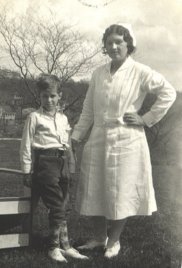
Gertrude, RN, with patient |
Gertrude Hoerman graduated from high school in Leonardville, valedictorian of her class. She graduated from nursing school at St. Luke’s School of Nursing in Kansas City. She worked as a private duty nurse in Kansas City for two years. The photo to the right shows her with a young patient in Kansas City.
On her parents’ wedding anniversary in 1933, Gertrude married the Reverend Charles (Carl) Platz. They were married at Lou and Bettie Hoerman’s home on their 34th wedding anniversary by Carl’s father, the Reverend C. E. Platz. Gladys was her sister’s maid of honor, while Lawrence Hoerman was the best man. Helena Cott played the piano. They made their home in Bern, Nemaha County, Kansas where Carl was a pastor.
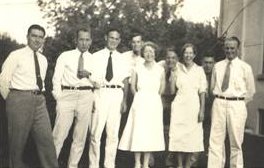
Dr. John Hertzler with interns and nurses at Hertzler Clinic in Halstead |
Gladys Hoerman graduated from high school in Leonardville with her twin sister Gertrude. She had developed an over-active thyroid (Grave’s disease) which required a lengthy hospitalization in Halstead at the Hertzler Clinic where Arthur Hertzler was a pioneer physician in evaluating and treating thyroid disorders.
While at Halstead, Gladys underwent surgical removal of her thyroid gland under local anesthesia. She recalls that “they had to hold my legs” because she was kicking during the surgery. After her recuperation, she returned home to help her mother. Shortly after returning home she recalls having a bushel basket of ironing to do, with threshers coming for dinner. Gladys was still so tired from her surgery, so she was glad to see cousin Minnie Weller Uhlenhop arrive to help. On the menu for the threshers that day were wieners. Minnie brought a rubber wiener and put it on the plate with the rest. The first thresher tried to stick the wiener with his fork repeatedly. It didn’t take too long for the diners to figure out the trick.
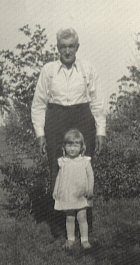
Lou Hoerman and granddaughter Betty Cott, about 1935 |
The photo at the right is of Lou Hoerman and his granddaughter, Betty Lou Cott, named after both her grandparents. The photo was taken in about 1935. Gladys and Wilbert were living at home when their father died in 1936, just a year after their brother Lawrence died. Lou was stricken with appendicitis, had surgery for that and died later in the Clay Center Hospital from a heart attack.
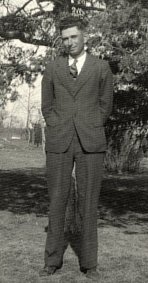
Wilbert Hoerman, 1938 |
Wilbert continued to manage the farm. Mike Rueck, a family friend from Germany, reportedly thought that he would take over the management of the farm, but Wilbert was now 31 years old and certainly was capable.
Farm records kept by Wilbert indicate some of the daily activities of the farm. In May 1937, Wilbert paid $575 for a combine. Harvest started that year on June 23rd and resulted in 673 bushels of wheat and 956 bushels of oats. The neighbors helped each other with harvest and Wilbert employed Charles Meyer to help him in addition. Eyeglasses from Buchmans in Clay Center cost $10.50 in 1937. A radio was purchased in December 1937 for $38.95, with the cost split between Wilbert, Gladys and their mother Bettie. In January 1938, Wilbert paid Henry Zeisset $29.45 for a hog. The next entry for the same day is for $3 to Hayes Butchering, so we know the fate of the hog. It cost $11.50 to license the car (a Plymouth), but only $4.25 to license the truck. Overalls at Sikes Store in Leonardville cost $2.25.
The canning record for 1944 indicates how Gladys and her mother, Bettie spent much of their time. A beef and a hog were butchered in January. Through the year the following items were canned: 21 quarts of mince meat, 30 quarts of beef soup, 11 quarts of liverwurst, 15 quarts of chili soup, 22 quarts of canned beef, 7 quarts of apples, 10 q. rhubarb, 26 q. asparagus, 3 q. peas, 58 q. mulberries and rhubarb, 4 q. beet pickles, 12 q. green beans, 28 q. beans, 60 q. pickles, 13 q. cherries, 9 q. beets, 8 q. apricots, 35 q. corn,
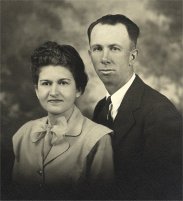
Wedding photo of Gladys and John Llewelyn |
Gladys married John Llewelyn in October 1945. They were married in Lost Springs, Kansas where Gladys’ uncle Andrew Hoerman was a pastor at the EUB church. John grew up at Bala, the son of Vaughn Llewelyn and Anna Bletscher. Anna Bletscher’s mother was Anna Baer, who grew up in Niedersteinach in Germany. The newlyweds lived exactly one mile north of the Hoerman home where Bettie and Wilbert continued to live.
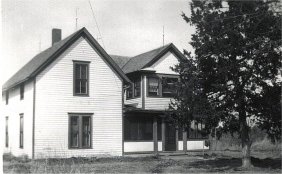
Hoerman home, 1949. Original house on left (west), addition including porch on right. |
After Gladys married John, Bettie and Wilbert were left on the farm. It was time to “update” the house. An addition on the east had been made years ago, but what was really needed was a new house. The house faced the road, now highway 24.
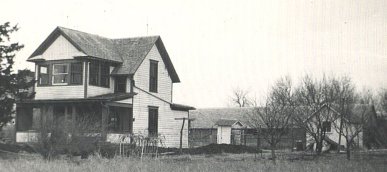
Hoerman home with outhouse, 1949 |
In the photo on the right, the outhouse can be seen near the center of the photo. Behind it is the chicken house, built in 1940. Gladys recalls as children when she and Gertrude ran naked from the house to the outhouse. Unfortunately they were seen by a passing neighbor, who was a bit of a busy body!
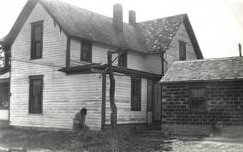
Hoerman home with cave house, 1949 |
In the photo on the left is the back of the house with the “cave house” which still stands at the farm today attached to the new home by a breezeway. Preparations for the new home began in March 1949. The builder is digging out a pipe in this photo.
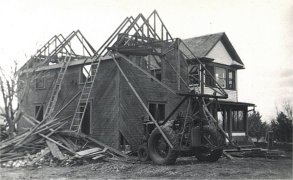
Original house being torn down |
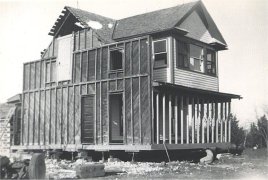
Addition prepared for move to Leonardville |
Bettie had experience in home design as she had participated in the design of the parsonage for the EUB church in Leonardville.
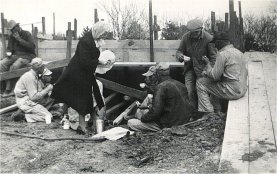
Workmen at lunch at Hoerman home |
The original part of the house on the west was torn down, while the addition on the east was moved into Leonardville where it remains today, having survived a fire in 1981.
Of course there were men to feed on the building project. And they appeared to be fed in style with china coffee cups!
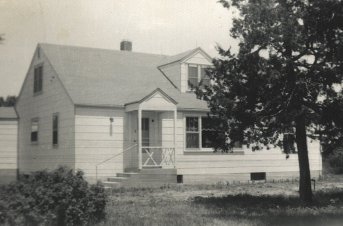
New Hoerman home, 1949 |
The new home was ready for occupation by harvest time.
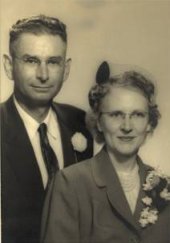
Wilbert and Mae Johnson Hoerman, married October 1954 |
Bettie didn’t occupy the new home for very long though as Wilbert had started courting a woman who worked in the grocery store in Leonardville. Wilbert married Mae Johnson in Oct 1954 and brought her to his home, where they lived together until Wilbert’s death in November 1979. The home is still owned by Wilbert and Mae’s son and daughter, but is occupied by Gary and Carla Hageman and family.
Bettie Hoerman moved in with her daughters after Wilbert’s marriage. She lived mostly with Gladys and John a mile north of Wilbert and Mae’s home. She lived as well with Gertrude and Carl Platz who were living in Hutchinson by this time.
Bettie had several grandchildren: Louise and Herman Cott had three children, Junior (Herman), Betty Lou and Jeanette. Gertrude and Carl Platz had two sons, Charles and Robert. Wilbert and Mae had two children, Lawrence and Loretta. The youngest grandchild was Loretta, born in 1957 and the oldest Junior Cott born in 1928. Betty Lou recalls that she spent quite a bit of time with her grandmother and that she was always telling her stories and giving her various bits of advice for her life.
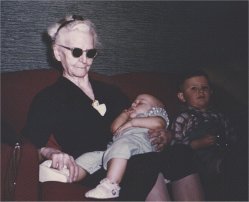
Bettie holding Loretta, with Lawrence, November 1957 |
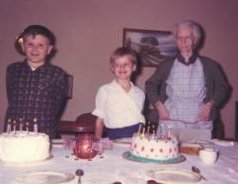
Loretta's 7th birthday party, with Lawrence and Bettie |
This photo at left from November 1957 with Bettie holding her youngest grandchild, Loretta Hoerman, with Lawrence sitting next to her. Bettie was 82 years old in 1957.
The photo to the right was taken at Loretta’s 7th birthday party, when Bettie was 85 years old. Notice the apron. No doubt there was butterscotch candy in the pocket. Bettie lived another nine years after this photo was taken.
Bettie Zeisset Hoerman lived with her daughters until it became too difficult to provide adequate care in the home. She gradually developed some type of dementia. She would often quote scripture in German. I can still hear her saying, “Markus, Lukas, Paulus”, three New Testament writers. She eventually went to live in the Prairie Nursing Home in Hutchinson in 1968. Her daughter, Gertrude Platz, worked as a nurse in this facility so as to continue to provide care for her mother. While Bettie was quoting scripture in German, her roommate was yelling “shut-up!” These were obviously not the most pleasant years. It had become quite difficult for her to eat.
One day, while she was being fed by a nursing assistant, she started choking and life slipped away from her. She died in Hutchinson on January 2, 1970 at 94 years of age. Her body was brought back to Leonardville, where her funeral service was held at the Leonardville United Methodist Church. Reverends Carl Platz, Lowell Wendland and David Bletscher officiated. Herman Cott, Jr. was the soloist, accompanied by his wife, Mary Ann Cott. Pall bearers were nephews John Swart, George Weller, Earl Zeisset, Carl Weller, Albert Nanninga and J. W. Zeisset. She was buried next to her husband in the Methodist church cemetery just south of Leonardville. At the time of her death, she had seven grandchildren and eleven great grandchildren.
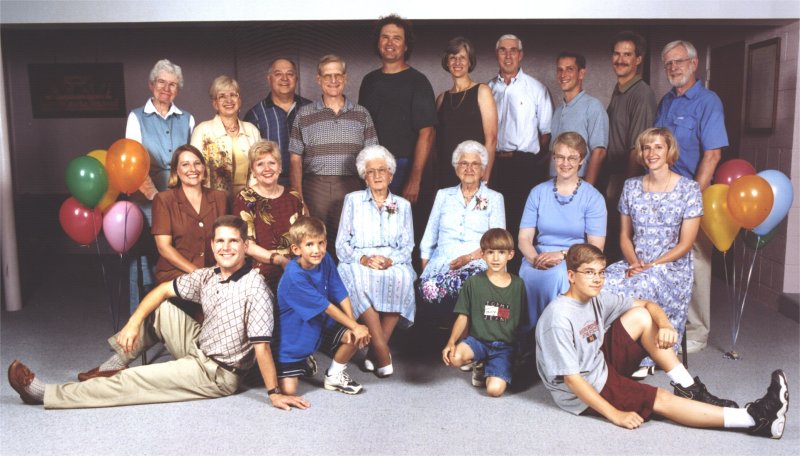
90th birthday party for Gertrude and Gladys, 2000, including all living descendants of Bettie and Lou. Standing: Betty Lou Cott Latimer, Jan Cott Kosarski, Ray Kosarski, Bob Platz, Lawrence Hoerman, Loretta Hoerman, Hugh O'Neill, Brian Platz, Chuck Platz, Charley Platz. Seated: Susan Platz Fraga, Sarah Platz, Gertrude Hoerman Platz, Gladys Hoerman Llewelyn, Jo Benda, Kristen Platz Adkins. On the floor: David Platz, Charles Daniel Platz, Benjamin David Platz and Andrew Mouser. |